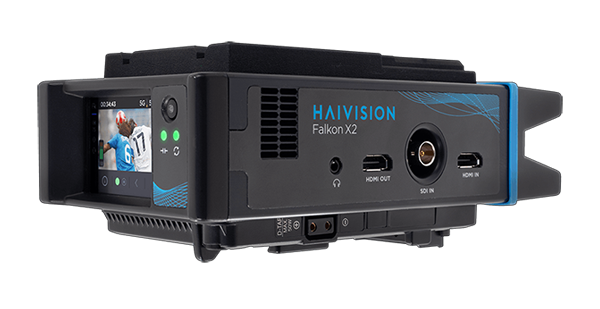A video encoder capable of streaming high-quality content over an IP network is a critical component of a modern live broadcast workflow. Whether it’s for live broadcast contribution in 4K UHD or multi-camera REMI remote production applications, confidence monitoring, or bi-directional interviews, selecting the best video encoder for your use case is a major decision. In this post, we’re highlighting the different broadcast use cases where video encoders play an integral role, key features to consider, and a guide to help you choose which video encoder is best for your live video application.
Let’s kick off with some common live broadcast use cases where a video encoder is essential.
- Field Contribution: Contribute high-quality ultra-low latency streams over any type of IP network, including the internet, from a remote location such as a sports venue or a remote correspondent back to a broadcast production center or cloud-based workflow.
- Remote Production or REMI: Encode and stream multiple camera feeds from a remote location at low latency and keep them in sync upon arrival at a centralized live production facility, without the need for deploying production teams and OB trucks.
- Return Feeds: Leverage low latency video in support of bidirectional feeds so that remote or home-based talent, directors, and producers can see live shots before and during a broadcast to communicate for cues and monitor feeds on portable monitors and mobile devices. Return feeds are also used for teleprompters and to provide bi-directional feeds for live remote interviews.
- Remote Collaboration: Get high-quality video where it needs to be in real-time for replay system operation, remote officiating, and commentary. Enable different talent and production staff to collaborate on a broadcast production when they are not all in the same location.
Key Video Encoder Features to Consider
Latency
In our 2021 Broadcast IP Transformation Report, we asked broadcast and streaming professionals what their biggest three challenges were and in third place behind transitioning to IP and enabling remote collaboration, 38% of those polled said that reducing broadcast latency was one of the top challenges they faced.
The drive towards low latency is constant and the ability for broadcasters to reduce glass-to-glass latency is clearly still a key concern. There are many factors that contribute to latency including the type of network used, a LAN or Internet for example, and the speed of the network, also known as RTT or the total round-trip time. The individual video processing components along the broadcast workflow as well as the choice of protocols and output formats can also affect latency. And of course, with more broadcasters relying on video streaming to support remote collaboration, latency between video production elements needs to be kept as low as possible.
There are several ways to minimize video latency without having to compromise on picture quality. The first is to choose a hardware encoder and decoder pair that has been engineered to keep latency as low as possible, even when streaming over a standard internet connection. The latest generation of video encoders can maintain low latency (under 50ms in some cases) and have enough processing power to encode video in HEVC at extremely low bitrates (down to under 3 Mbps for HD content) all while maintaining high picture quality.
Another key factor in lowering latency is to select a video transport protocol that will deliver high-quality video at low latency over noisy, public networks like the internet. Successfully streaming video over the internet without compromising on picture quality, requires some form of error correction to prevent packet loss. Packet loss recovery approaches will introduce latency, but some more than others. The Secure Reliable Transport (SRT) open-source protocol leverages ARQ error correction to help prevent packet loss while introducing less latency than other approaches including RTMP.
Quality
How important is video quality to your application? Just because broadcast applications demand low latency, doesn’t mean that quality needs to be compromised. There are video encoders that can stream in HD, HDR, and 4K UHD with 10-bit color spaces and 4:2:2 chroma subsampling at low latency.
Security
Broadcasters’ live video content is extremely valuable, so the video encoder you use must be both extremely secure and reliable. Look for enterprise-grade security and support for AES-128/256 encryption when transporting live video across IP networks including the internet.
Reliability
Depending on the situation, some video encoders may have to contend with unpredictable IP networks such as the public internet. In order to ensure the reliability of the live video stream, some video encoders have features like adaptive bitrate encoding, SRT with packet loss recovery, and hitless failover over redundant networks to ensure that the best quality video possible is always available and mitigate the risk of streams failing.
Multi-Camera Support
For remote production or REMI-type workflows where multiple cameras are involved, consider a video encoder that can support multiple SDI inputs. If the video feeds are not synchronized to each other as well as to the main audio stream, switching between cameras can result in issues detrimental to the viewing experience such as input lag or lip-sync delay. Some video encoders can not only encode all the inputs simultaneously, but they can embed timecodes so that they can easily be kept in sync by a paired decoder.
Flexible Form Factor
Flexible deployment options from ultra-compact appliances to high-density chassis solutions are a must-have in many use cases, especially where space is at a premium. A portable, lightweight video encoder can be easily used anywhere whether it is integrated into a flypack for use in the field, as part of a home-based setup, or simply whenever there is a need to minimize the footprint where limited space is available. Some situations might even call for a ruggedized video encoder designed to withstand harsh environments.
Codec and Transport Protocol Support
It’s always good to have options. Choose a video encoder that supports the video transport protocols best suited to your streaming application; for streaming encrypted video with packet loss recovery at extremely low latency, for broadcast contribution or live event production, consider a video encoder that has native support for SRT.
Ease of Use and Support
This is more a function of who is operating the video encoder. While many broadcast engineers will be familiar with a variety of video encoders and hardware, some organizations may need a more user-friendly device with support available to them. Choosing an encoder with a web-based user interface makes it easy for system administrators to remotely configure a video encoder.
Which Video Encoder is Right for Me?
Across all the industries it serves, including broadcast, Haivision has become a brand synonymous with high-quality, ultra-low latency video encoders. Our flagship Makito family of video encoders and decoders is trusted and relied upon by the world’s leading broadcasters to power their 24/7, high-quality, low latency workflows.


























